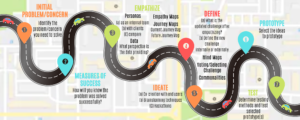Define is the second step in the design thinking process. It occurs after empathizing with users to looks to identify a clear problem statement. Defining your problem or challenge involves analyzing what was discovered during the empathize phase and synthesizing what was learned in the form of a problem statement. After all, it’s challenging to create solutions for a problem that your team cannot articulate. Therefore, the problem statement is vital to help you gain clarity for the third step in the process, Ideation.
Writing a problem statement may be challenging. The amount of information found during the empathize phase – the experiences, data, interviews, notes, observations, and other ideas – can be abundant. It can help to list all of the challenges identified in the empathize phase in a single place. You can use a large board or wall and use sticky notes to move around or group different ideas. Depending on the problem, designers will use different tools to organize these ideas to connect the dots and develop new insights. Examples of some tools you might encounter during the define phase are:
- Mind Maps
- Fishbone Diagrams
- Affinity Diagrams
- Entity Diagrams
- 5 Whys
To craft your problem statement, make sure it is clear and attainable but broad enough to accommodate creative solutions. Make sure your problem statement:
- Addresses what was discovered during the empathize phase.
- Does not list a specific method or step-by-step technicalities to allow for creative freedom.
- Is worded as a “How might we…” statement.

Design thinking seeks to solve human-centered problems and reflect the human need instead of the organization’s need. We recommend that the wording of the problem statement should address the human need rather than the company’s needs. For example, a problem statement like this: “The company must increase sales of mobile phone plans to the senior’s demographic by 80%” should be worded as: “How might we create a mobile phone plan for seniors who are looking for the least expensive and simplest option?”
The define phase of design thinking can be the most exciting step in the process. It provides clarity on the problem you are trying to solve for your users. Take as much time as you need to craft a problem statement that aligns best with the challenge you have identified during the empathize phase. It’s important to share your final problem statement with your team and other stakeholders to ensure that everyone is aligned with the goal you are trying to achieve and set the stage for great ideas to emerge in the following phase, Ideation.
For more information about the define phase, check out our video here:
As part of Spring2 Innovation’s Design Thinking Certificate, we teach you how to master all five phases of the Design Thinking methodology. We teach learners how to apply Design Thinking tools and methods from a solution-based lens with the end-user in mind.

